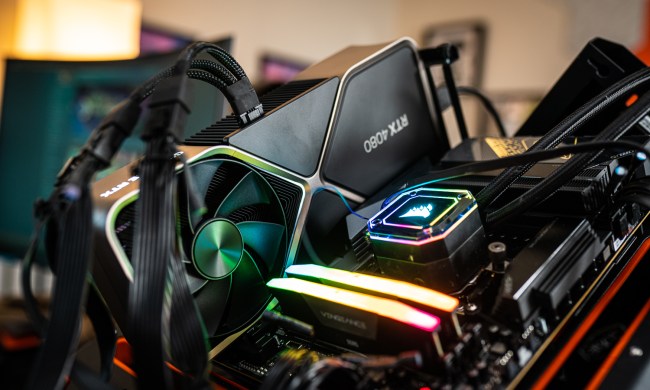“The Kova’s ambidextrous design and button layout set it apart from the competition.”
- Ambidextrous design
- Unique and useful Easy-Shift[+] buttons
- Fair price
- Versatile button layout
- Low sensor DPI
- Messy software
- Limited lighting options
Roccat isn’t the most well-known company dedicated to PC gaming peripherals. You won’t find its products lining the shelves in your local Best Buy.
That’s a shame, especially in the case of the Kova. On close inspection it’s apparent the button placement, particularly the “bumper” buttons on either side of the primary left and right clickers, are unique and useful. The Kova is therefore somewhere in between the paradigms of “shooter” mice and MMO-style mice.
The argument for the Kova is augmented by its affordable $50 price tag and ambidextrous design. While there are less expensive mice on the market, Roccat’s competitor looks well equipped in the mid-range market, with a 3,500 DPI sensor and four extra “easy-shift” buttons. Let’s see if this mid-range mouse can measure up.
A typical mouse with something extra
The Kova is a standard ambidextrous mouse, equally comfortable in either hand. Its high and wide curves are skillfully hidden, so that the mouse feels bigger (and more comfortable) than it looks. As with most modern gaming mice, all of the buttons are tuned for quick presses and easy selection with a thumb or finger.
The mouse’s basic blueprint makes it the contemporary of “shooter” mice like the Razer DeathAdder. A high back and two big thumb buttons on either side are ideally placed for fast-paced secondary actions, like lobbing grenades or a quick melee attack. There’s also a dedicated DPI button just below the mouse wheel, though it’s somewhat lonely – with no up or down rocker, you’ll have to cycle through all of the DPI steps instead of going higher or lower. The wheel itself is fairly basic, with no left or right rocker functionality.
Secondary action buttons are what make the Kova unique.
The bottom of the mouse has a symmetrical foot layout that further supports the ambidextrous design, and a 3,500 DPI optical sensor. The braided cord is serviceable, but a little shorter than competitors, a two meters in length.
Secondary buttons are what make the Kova unique. It has two “rocker” buttons on either side of the primary left and right click buttons. These extra buttons (making for eight standard buttons, plus the center-click on the wheel and the DPI switch, for a total of ten) are flared up to either side. They’re easy to hit with an index or middle finger, using either a quick tap or a “roll” motion.
The mouse features two LED strips on either side of the mouse wheel, and a large bar at the “bottom” of the mouse, which shines down on whatever surface the mouse is used on to create a “ground effect” look. Both LEDs support a variety of color options, which can be chosen with the Kova’s software.
Bumper fun
The Kova is comfortable, but not exceptionally so, and the button placement works well for both palm and claw grips. The thumb buttons are big and easy to hit in fast action games, and impressively, they’re not so trigger-happy that you must disable the buttons opposite your preferred grip. With care, the extra buttons can be bound to less-frequent items and used in-game without worrying about accidental clicks.
It’s the bumper buttons, which Roccat rather awkwardly refers to as “Easy-Shift[+],” that make the Kova stand out. These secondary index and middle finger buttons are ideally placed — far enough away from the standard buttons that you’ll never hit them by accident, but close enough that they can be clicked more or less instantly.
In addition to two thumb buttons on either side, the bumpers give the mouse six alternative action buttons, not counting the DPI switch. This puts the design between “shooter” mice, which rarely have more than two, and mice designed for use with MMO and MOBA games, which tend to have at least nine.
The 3,500 DPI sensor is yawn-worthy on paper, but it worked well enough in practice.
The middle-of-the-road design is surprisingly adaptable. In role-playing games, like Fallout 4, I bound the left and right bumper buttons to the map and inventory respectively, making both of them available without having to look down at my keyboard. In more fast-paced fare like Titanfall, I used them for calling in my Titan and quickly glancing at the scoreboard. In Mount & Blade I used them for shortcuts to troop movement commands, a formerly awkward motion switching from my Tartarus gamepad to the function row on my keyboard.
Roccat’s marketing seems to indicate it wants gamers to use the Kova in extremely intricate scenarios. The software supports complex macro bindings and combination-presses. I’ve never been all that comfortable with overly-complex mouse binds, preferring to leave that to my relatively stationary left hand. If you find shooter mice too simple, but think MMO mice too overwhelming, the Kova will feel like the right compromise.
Senior sensor
While most mice opt for a laser sensor these days, the Kova uses a somewhat antiquated optical sensor with a maximum DPI of 3,500. Roccat’s “overdrive” mode engages some technical trickery to fake the DPI up to 7,000. Conventional gamer wisdom says that LED sensors are better for standard mousepads and other ideal surfaces than laser sensors, which were developed to make mice track evenly on any surface.
I found the Kova’s relatively under-powered sensor more than a match for both fast-paced games and more precise desktop use. After reviewing many gaming mice I’ve found the insanely-high DPI sensors on more expensive mice more or less useless, even for intense sniping sessions, so a step down on the spec sheet with a corresponding dip in price is an ideal trade-off.
Software almost spoils the fun
Roccat couldn’t resist making its Swarm configuration app look like the controls of an alien spaceship, and that’s not a good thing. Navigating the software is a major headache, as functions never seem to be where expected.
Luckily, Roccat includes storage on the mouse itself, so once you have it working to your satisfaction you won’t need to mess with it again. The software allows for nearly unlimited key binds, macros, button combos, customized vertical and horizontal scales, and a setting that can be used to customize the DPI change that occurs when its button is triggered. There’s even an audio option that announces the Kova’s current DPI setting, in case you forget.
The Kova’s lighting, controlled through the same software, is lacking. Gamers can specify independent colors for the mouse wheel the bottom light bar, choose between always-on, blinking, and breathing effects, and set the colors to cycle, but that’s it. Competitors, most notably Razer, offer more customization, along with more attractive lighting.
Conclusion
The DT Accessory Pack
Up your game with these accessories, hand picked by DT editors:
Razer Tartarus Chroma Gamepad ($80)
Razer’s Tartarus gamepad makes for an excellent alternative to a full-sized (and expensive) gaming keyboard.
Roccat Alumic Double-sided Mousepad ($46)
Picky gamers who insist on optical sensors will love this big, rigid, and double-sided pad.
Gamdial headset stand/mouse bungee/USB hub ($25)
This inexpensive gadget will hold your gaming headset, keep your mouse wire out of the way, and add some USB ports to your desktop.
The Roccat Kova is a serviceable mouse that doesn’t stand out or fall flat in any particular category, and that alone would make it a decent option at $50. But the addition of extra buttons on either side of the primary left and right buttons, which are both functional and easy to use, raises its in-game utility above its pedestrian design.
Alternatives to the Kova include Logitech’s G502, Razer’s Deathadder Chroma, and Corsair’s M65. These mice have a leg up on Roccat in DPI, with the Logitech hitting a high of 12,000. However, as mentioned, greater sensitivity doesn’t always translate to better performance. Where these competitors truly excel is in button count (in the case of the Logitech) or build quality (with the Razer and Corsair).
The Kova’s feature set and aesthetic is mediocre compared to these popular options, but its ambidextrous design and bumper buttons set it apart. Gamers who want a mouse that’s great for southpaws will love the Kova, as will those seeking a compromise between shooter and MMO mice.
Highs
- Ambidextrous design
- Unique and useful Easy-Shift[+] buttons
- Fair price
- Versatile button layout
Lows
- Low sensor DPI
- Messy software
- Limited lighting options












